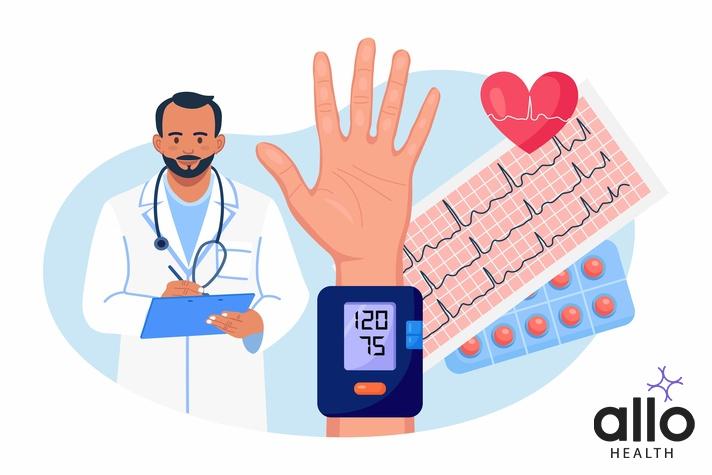Understanding Diffuse Physiological Arousal

Allo Health is dedicated to personalized well-being, offering support and trusted information tailored to individual health goals. The platform emphasizes human-generated content, led by a distinguished medical team of experts, including physicians and sexual health specialists. Their commitment to credibility involves rigorous fact-checking, authoritative research, and continuous updates to ensure accurate, up-to-date information. Allo Health's unique approach goes beyond conventional platforms, providing expert-led insights and a continuous commitment to excellence, with user feedback playing a crucial role in shaping the platform's authoritative voice.

Dr.Sushma.V completed MBBS degree from BGS GIMS,bangalore
Why This Was Upated?
Our experts continually monitor the health and wellness space, and we update our articles when new information became available.
Updated on 20 May, 2024
- Article was updated as part of our commitment to diversity, equity, and inclusion.

"The following blog article provides general information and insights on various topics. However, it is important to note that the information presented is not intended as professional advice in any specific field or area. The content of this blog is for general educational and informational purposes only.
Book consultation
The content should not be interpreted as endorsement, recommendation, or guarantee of any product, service, or information mentioned. Readers are solely responsible for the decisions and actions they take based on the information provided in this blog. It is essential to exercise individual judgment, critical thinking, and personal responsibility when applying or implementing any information or suggestions discussed in the blog."
Understanding Diffuse Physiological Arousal is crucial for comprehending how our bodies respond to various stimuli and situations. This phenomenon refers to the overall activation of the autonomic nervous system, leading to changes in heart rate, breathing, and other bodily functions. By exploring the mechanisms behind diffuse physiological arousal, researchers can shed light on its role in stress, anxiety, and other emotional experiences. This article delves into the intricacies of diffuse physiological arousal, its implications, and potential therapeutic interventions.
What is Diffuse Physiological Arousal?
Diffuse Physiological Arousal, also known as flooding, refers to a state of heightened physiological arousal experienced by individuals when they are overwhelmed by intense emotions or stressors. This response involves activation of the autonomic nervous system, leading to rapid heart rate, shallow breathing, sweating, and muscle tension.
Flooding can occur in various situations, such as during traumatic events, moments of extreme anxiety, or when confronted with overwhelming stimuli. It can impair cognitive functioning and make it difficult for individuals to regulate their emotions effectively. Managing flooding typically involves techniques such as deep breathing, relaxation exercises, and cognitive restructuring to reduce arousal levels and regain control.
The Science Behind Diffuse Physiological Arousal
DPA, or Dialectical Behavioral Therapy (DBT) Prolonged Exposure, and flooding are two therapeutic techniques used to treat anxiety disorders, particularly those stemming from trauma. Both approaches aim to reduce anxiety by exposing individuals to feared stimuli in a controlled environment.
The science behind these techniques lies in the principles of habituation and extinction. By repeatedly exposing individuals to the feared stimuli, their anxiety response gradually decreases over time as they learn that the stimuli or arousal mechanism is not as threatening as originally perceived. This process helps individuals develop coping skills and resilience, ultimately leading to reduced anxiety and improved overall well-being.
Symptoms and Signs of Diffuse Physiological Arousal

- Increased heart rate: A rapid heartbeat is often a prominent symptom of physiological arousal, indicating the body’s heightened state of alertness.
- Elevated blood pressure: The body may experience an increase in blood pressure as a result of heightened arousal, which can contribute to feelings of tension and stress.
- Sweating: Excessive sweating, particularly in the palms, armpits, and forehead, can be a common sign of physiological arousal.
- Muscle tension: Individuals may experience tightness or tension in their muscles, particularly in the neck, shoulders, and jaw, as a result of heightened arousal.
- Shallow breathing: Rapid, shallow breathing is another common symptom, as the body prepares for a fight-or-flight response.
- Increased alertness: Heightened vigilance and sensitivity to stimuli in the environment may occur as a result of physiological arousal, as the body prepares to respond to potential threats.
Overall, recognizing these symptoms can help individuals identify and manage physiological arousal more effectively.
Causes of Diffuse Physiological Arousal
- Stress: Diffuse physiological arousal can be triggered by stressors such as work pressure, financial worries, perpetual conflict, or relationship trouble.
- Anxiety: Feelings of worry or apprehension can lead to heightened physiological arousal, including increased heart rate and sweating.
- Fear: When faced with a perceived threat or danger, the body’s fight-or-flight response is activated, resulting in diffuse physiological arousal.
- Physical exertion: Engaging in intense physical activity can cause the body to enter a state of heightened arousal to meet the demands of the activity.
- Caffeine or stimulant intake: Consumption of substances like caffeine can stimulate the central nervous system, leading to increased physiological arousal.
- Lack of sleep: Insufficient rest can disrupt the body’s natural regulatory processes, resulting in heightened arousal levels.
- Medical conditions: Certain medical conditions, such as hyperthyroidism which also impacts male fertility, or panic disorder, can cause chronic physiological arousal.
Role of the Sympathetic Nervous System in DPA

- Regulation of bodily functions: The sympathetic nervous system plays a crucial role in regulating various bodily functions, including heart rate, blood pressure, and respiration.
- Stress response: When faced with a stressful situation, the sympathetic nervous system becomes activated, leading to the release of stress hormones such as adrenaline and noradrenaline.
- Fight or flight response: The activation of the sympathetic nervous system triggers the “fight or flight” response, preparing the body to either confront the threat or flee from it.
- Increased alertness: Diffuse physiological arousal, facilitated by the sympathetic nervous system, leads to heightened alertness and increased vigilance, enabling individuals to respond effectively to potential threats.
- Mobilization of energy: The sympathetic nervous system stimulates the release of glucose from the liver and fatty acids from adipose tissue, providing the body with the energy necessary to cope with stressful situations.
Importance of Flooding in a Relationship
After extensive research spanning over four decades and involving more than 3000 couples, John Gottman identified a common phenomenon in struggling relationships: heightened physiological arousal in both partners, leading to overwhelming stress. Known as Diffuse Physiological Arousal (DPA) or flooding, this response is an evolutionary mechanism designed to mobilize individuals in times of crisis.
When faced with a perceived threat, such as conflict with a partner, our bodies react instinctively with increased heart rate, adrenaline release, and diminished reasoning capacity, priming us for fight or flight. This primal response, once vital for survival against predators, now manifests in interpersonal conflicts.
Impact of Flooding
- Managing Diffuse Physiological Arousal (DPA) is crucial during conflict discussions to maintain productive arousing communication.
- Failure to manage DPA can hinder the progress of discussions by triggering fight-or-flight responses.
- When flooded with DPA, individuals may exhibit critical, contemptuous, defensive, or avoidant behaviors.
- Flooded individuals experience a reduced ability to process information, making it difficult to pay attention and problem-solve.
- Being flooded with DPA diminishes empathy, humor, and understanding, making it challenging to be a good listener.
- Resolving the concerns becomes unlikely when flooded with DPA, and continued conversation may exacerbate the situation and lead to further harm.
How to Reduce the Effects of Flooding?
- Initiate a flooding time-out by using a key phrase when you or your partner are flooded.
- Recognize flooding as soon as it begins and implement techniques to reduce it.
- Separate for at least 20 minutes, engaging in self-soothing activities like walking, meditation, or reading.
- Avoid replaying the argument during the time-out; focus on calming your body and mind.
- If still flooded after the time-out, repeat the process until calm enough to resume communication.
- Seek behavioral therapy to uncover underlying dreams and needs behind conflicts once you’ve mastered recognizing and managing emotional flooding.
Ways to Manage DPA or Flooding
- Measure Key Biomarkers: Assess your baseline levels of hs-CRP and cortisol through various WellnessFX panels. Hs-CRP indicates inflammation levels, which can impact mental health and even the healthiest relationships, while cortisol levels reveal stress responses. Maintaining optimal levels of these biomarkers is crucial for overall well-being and mental health.
- Consider Inflammation and Stress: High levels of hs-CRP indicate inflammation, which is linked to depression and other mental health conditions. Monitoring your hs-CRP levels can help prevent prolonged depressive symptoms. Similarly, cortisol levels reflect stress responses, with chronically elevated levels indicating persistent stress. If your cortisol levels are consistently high, it may be time to take action.
- Seek Professional Support: Consult with a Licensed Marriage and Family Therapist (LMFT) to address conflict styles and relationship conflict contributing to stress. LMFTs offer systemic approaches to therapy, helping individuals and couples develop coping strategies and resolve underlying concerns.
- Practice Mindfulness Meditation: Engage in mindfulness meditation to reduce anxiety and depression by exploring and managing stress triggers. Mindfulness therapy allows for acceptance and perspective shift, promoting emotional resilience.
- Monitor Heart Rate Variability (HRV): Track your HRV to gauge your body’s response to stressors and assess autonomic nervous system function. HRV reflects the balance between the sympathetic and parasympathetic branches, offering insights into resilience.
Treatment Options for DPA
- Psychotherapy: Cognitive-behavioral therapy (CBT) can help individuals identify and challenge negative thought patterns contributing to physiological arousal.
- Medication: Antidepressants or anti-anxiety medications may be prescribed to alleviate symptoms of arousal.
- Stress management techniques: Mindfulness meditation, deep breathing exercises, and progressive muscle relaxation can help reduce overall arousal levels.
- Lifestyle modifications: Regular exercise, adequate sleep, and a healthy diet can support overall well-being and reduce physiological arousal.
- Biofeedback: This technique teaches individuals to control their physiological responses through real-time monitoring of bodily functions such as heart rate and muscle tension.
- Relaxation techniques: Yoga, tai chi, and guided imagery can promote relaxation and reduce arousal levels.
Long-Term Effects of Untreated DPA
Untreated DPA can have long-lasting effects on both physical and mental health. It can increase the risk of developing chronic anxiety disorders, depression, and other mental health conditions. It can also significantly impact physical health by contributing to high blood pressure, heart disease, and other cardiovascular problems.
Understanding the Connection Between Trauma and DPA
Understanding the link between trauma and diffuse physiological arousal (DPA) is crucial for addressing mental health challenges. Traumatic experiences can trigger a heightened state of physiological arousal, leading to symptoms like increased heart rate, sweating, and muscle tension. This heightened arousal can persist long after the traumatic event, contributing to conditions such as anxiety and PTSD. By comprehending this connection, mental health professionals can develop more effective interventions aimed at regulating arousal levels and alleviating the symptoms of trauma-related disorders.
Conclusion
In conclusion, understanding diffuse physiological arousal (DPA) is crucial for comprehending how the body responds to various stimuli and stressors. By recognizing the signs and symptoms of DPA, individuals can effectively manage their physiological arousal levels and mitigate the negative impact on their mental and physical well-being. Through mindfulness practices, relaxation techniques, and stress-reducing strategies, individuals can cultivate a greater sense of self-awareness and resilience in navigating the challenges of daily life. Ultimately, fostering a deeper understanding of DPA empowers individuals to lead healthier and more balanced lives.
Most Asked Questions
-
What is diffuse physiological arousal (DPA)?
Diffuse physiological arousal refers to a state of heightened physiological activation that occurs in response to stress or emotional stimuli. It involves changes in various bodily functions such as heart rate, blood pressure, sweating, and muscle tension, without a specific focus or trigger.
-
What are the symptoms of diffuse physiological arousal?
Symptoms of DPA can include increased heart rate, rapid breathing, sweating, muscle tension, trembling, and a general feeling of agitation or unease. These symptoms may vary in intensity depending on the individual and the level of arousal experienced.
-
What causes diffuse physiological arousal?
DPA can be triggered by a variety of factors, including stress, anxiety, fear, excitement, or other intense emotions. It can also result from physiological responses to environmental stimuli, such as loud noises or bright lights.
-
How does diffuse physiological arousal affect mental health?
Experiencing frequent or prolonged episodes of DPA can contribute to feelings of anxiety, overwhelm, and difficulty regulating emotions. It may also interfere with cognitive functioning and contribute to symptoms of burnout or chronic stress.
-
Can diffuse physiological arousal be managed or treated?
Yes, strategies for managing DPA may include relaxation techniques such as deep breathing, mindfulness, progressive muscle relaxation, and engaging in activities that promote a sense of calm and well-being. In some cases, therapy or medication may be recommended to address underlying issues contributing to heightened arousal levels.






































